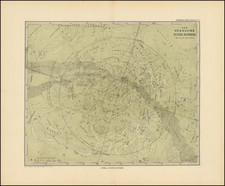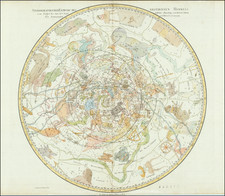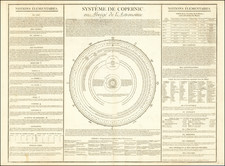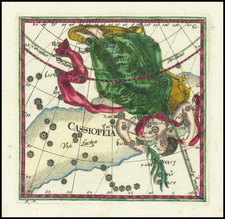John Senex (1678-1740) was a successful London cartographer, engraver, and publisher of maps and books. In addition to producing many terrestrial maps and globes, he took a keen interest in astronomy and was elected as a Fellow of the Royal Society in 1728.
Senex was well connected within the elite world of British scientists, and some of his maps were produced in partnership with such 18th century luminaries as Charles Price, James Maxwell, Edmond Halley and William Whiston. It is Whiston - a prominent English theologian who succeeded Isaac Newton as Lucasian Professor at Cambridge in 1702 - who is credited with creating the "scheme of the solar system" shown at right.
Although several versions of this diagram were published, those produced by Senex are the most impressive, ensuring their continued popularity. Senex's widow Mary continued his business after his death in 1740, and his maps were still being reprinted in the 1760's by Robert Sayer and John Bowles. Warner (1979) quotes an advertisement for this map by John Bowles, from 1768.
The broadside displays the latest discoveries and theories of planetary revolution based on the works of the great English astronomers Sir Isaac Newton, his successor at Trinity College in Cambridge, William Whiston, and Dr. Edmund Halley (1656-1742). The map is intended to convey the relative distances, sizes, and orbital periods involved in the motions of the Solar System's planets and major comets. The collaborative nature of Senex's mapmaking practice is particularly evident here, as the map makes use of Halley's observations and Newton's theories and mentions the work of Astronomer Royal John Flamsteed. It is impressive for its level of textual and artistic detail, each orbit being formed by a line of text that describes the corresponding planetary body. The surrounding text proclaims the correctness of the Copernican system and describes the motion of each of the planets in greater detail.
John Senex (1678-1740) was one of the foremost mapmakers in England in the early eighteenth century. He was also a surveyor, globemaker, and geographer. As a young man, he was apprenticed to Robert Clavell, a bookseller. He worked with several mapmakers over the course of his career, including Jeremiah Seller and Charles Price. In 1728, Senex was elected as a Fellow of the Royal Society, a rarity for mapmakers. The Fellowship reflects his career-long association as engraver to the Society and publisher of maps by Edmund Halley, among other luminaries. He is best known for his English Atlas (1714), which remained in print until the 1760s. After his death in 1740 his widow, Mary, carried on the business until 1755. Thereafter, his stock was acquired by William Herbert and Robert Sayer (maps) and James Ferguson (globes).













![[Moon by Domenico Cassini]](https://storage.googleapis.com/raremaps/img/small/82740.jpg)
![[Virgo]](https://storage.googleapis.com/raremaps/img/small/79551.jpg)